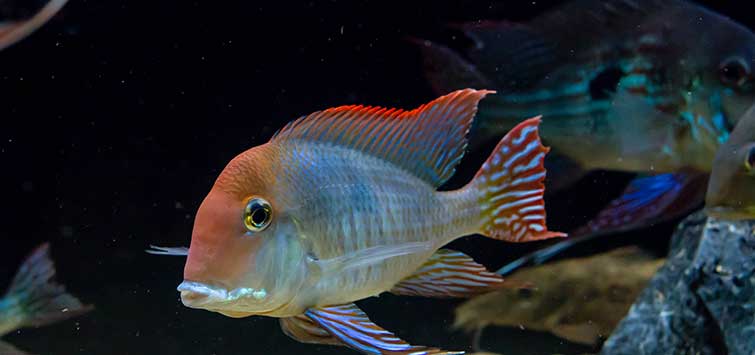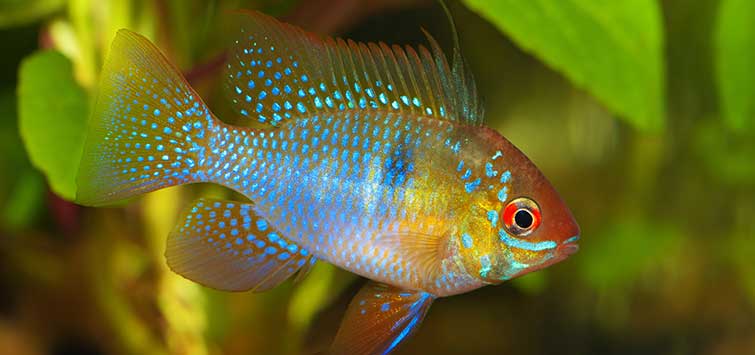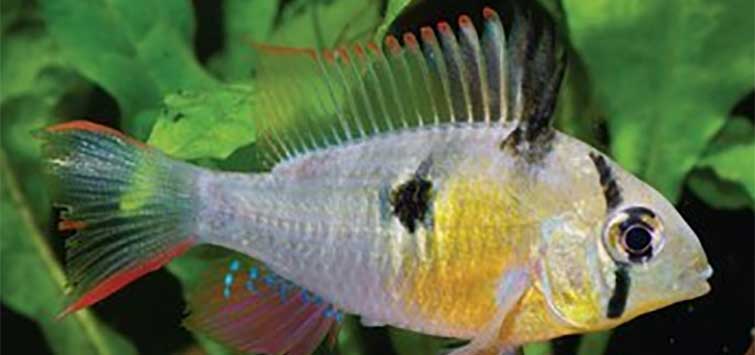Geophagus sp. "Rio Tapajos Red Cap": An Unclaimed Amazon Jewel
Author: Bob Allen
Wondering what the best cichlid out there might be? One fishbreeding expert proposes that it might be a little cichlid you have probably never heard of, a personable fish that is anything but shy or reclusive, and with color to match!
Rio Tapajos Red Cap Basics
At first, I wasn’t quite sure why I bought Geophagus sp. “Rio Tapajos red cap.” I had never seen it before, but I had a hunch that it would be an interesting fish. It is an undescribed species from the Rio Tapajos (an Amazon tributary in Brazil) that is often called “red cap” or “orange cap.” My new fish came to me from a fellow hobbyist, Jackie Stuver, and were wild-caught.
Appearance
The fish resembles Geophagus altifrons or G. surinamensis, but vive la difference! This fish has intense color: turquoise blue and red striations, and a red cap that extends up its back. The red color is unusual, hence the “orange cap” name. Actually, the color isn’t really red or orange, but more like cinnamon—only brighter.
The red cap is also smaller than altifrons. I have a pair of altifrons that are 8 inches long each; by contrast, the red caps are each about 5 inches.
These fish have interesting and agreeable personalities. My fish get very excited upon my approach, or that of anyone who might have food—a little bit like an oscar, without the feeder goldfish. They are not shy or reclusive, and again, these are wild-caught fish! The tiny fry are also frantic feeders; they will nip at your hands like the little cyprinid “doctor fish” we have been reading about that pick dead skin off of customers’ feet in pedicure salons.
Breeding
The social and mating behaviors of red caps are peculiar. The ones I have are in a custom 75-gallon tank that is 15 inches high, 48 inches long, and 22 inches wide, like a regular 75 lying on its side. I have two pairs of adult fish. They are perpetual bonded pairs, and one pair stays at each end of the tank except at feeding time. They sometimes spar with each other but rarely do any harm. When they spawn, the female places 200 or so smallish eggs in a place cleared of sand. After the eggs are laid, they are sometimes partially covered with sand.
Two to three days after spawning, one or both of the fish pick up the eggs and carry them in their mouth(s)—they are delayed, bi-parental mouthbrooders. The pattern of the egg care is irregular; oftentimes, the eggs are first picked up by the male and then later passed to the female, but this may be reversed. In this process, I did once witness a felonious act by one of the fish. When one pair was exchanging the fry, the male from the other pair slipped in and snacked on one of the fry. I was hoping he was just trying to help—clearly he wasn’t.
I have always stripped whichever fish is holding the fry. The previous owner of these fish left them with the parents until they were released, and the parents continued to protect them. Because she had them in a community tank, she couldn’t leave the fry with the parents for very long. If I get a little further ahead with the numbers of fry, I would like to see if they would tend the fry better than the African mouthbrooders I am more familiar with. I’m sure they would have a better chance if the pairs were isolated, as I fear the “snacker” would take his toll if they were left together.
The fry grow fairly quickly but are quite small to begin with (about ¼ inch), so it takes them a while to reach maturity. The fry are even more enthusiastic about food than the parents, making a tumultuous scene when all 200 try to be in the same spot to get fed.
Aquarium Care
Red caps are very adaptable. The water in my part of Utah is hard (200 to 300 ppm, pH 8), almost certainly harder than the water of the Rio Tapajos. In addition, my tanks have oolitic sand from the Great Salt Lake, which is very basic. My fellow fishkeepers predicted that there would be trouble, but I’ve had no problems. Brine shrimp is the prevailing food around here, and they thrive on it. I would be very surprised if there is any kind of fish food they wouldn’t eat. I haven’t tried them in a community tank, but together they are neither wimpy nor very belligerent. Their size is also about perfect—it is sometimes hard to make a very tiny fish into a pet, but a 3-foot arowana or 40-pound Amazon red-tailed catfish could also be a problem to keep.
New or Old?
Is the red cap really a new fish? An importer acquaintance of mine reports that he first imported it about 12 years ago, but, for whatever reason, my fellow fishkeepers have only heard about it quite recently.
There is a certain process by which fish are inducted into the aquarium hobby, and it looks as if this fish misconnected. When fish are first discovered, they are in the “new” or “rare” category, which makes them of particular interest to the hardcore, specialized hobbyist—the person who will pay serious money. Some fish never get out of this category. An example is the related Satanoperca (Geophagus) daemon, the fish that perishes in almost everybody’s tank. S. daemon is unlikely to ever be found as a bargain-priced juvenile fish. The situation with the red cap appears to be the opposite; it breeds readily in aquariums, is not hard to keep, and is perhaps viewed by hardcore cichlid folks as being too easy.
I have now been keeping fish for quite a few years. Currently I am maintaining 240 tanks, mainly of Tanganyikan cichlids. One thing I am sure of is that all fish are not created equal, at least as far as their value as aquarium dwellers. I have noted that some of my fellow veteran aquarists (Lee Finley and Wayne Leibel, in particular) have in their writings identified fish that are their all-time favorites, and fish that are a particular challenge to breed. In my tanks, a consistent favorite is Cyathopharynx furcifer from Tanganyika, which is a fish that is both spectacular in appearance and behavior, building a huge crater nest to showcase its courtship choreography. I have been working on and off with furcifer for years, but I didn’t expect to find a new South American fish that could become one of my all-time favorites.
Is Geophagus sp. “Rio Tapajos red cap” the best new cichlid to be found in the last 20 years? It’s your call!
See the full article on TFH Digital http://www.tfhdigital.com/tfh/200907/#pg73

.png?h=595&iar=0&w=2781&hash=5FD5E69473BCC22199FBFA2FB71B6033)



